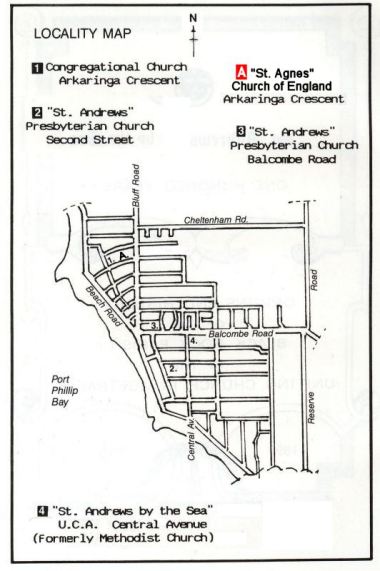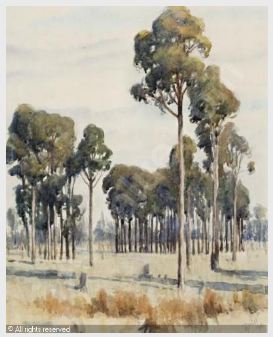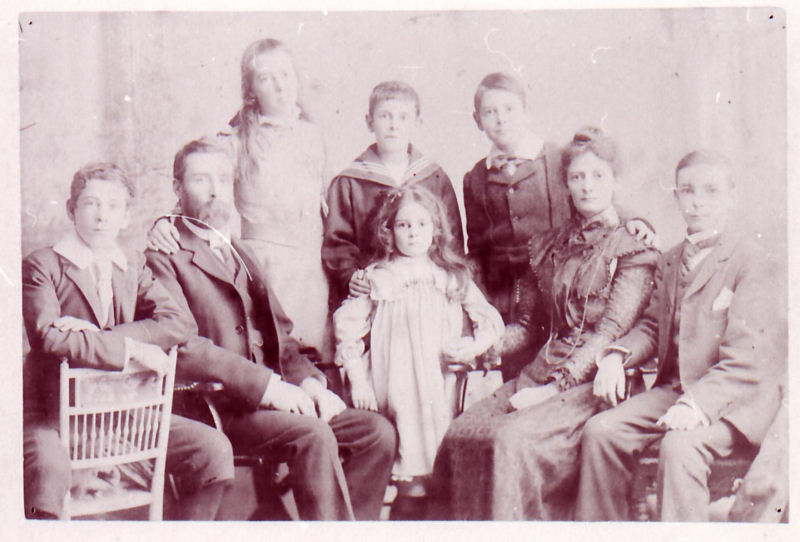|
St Agnes Anglican Church
Celebration of One Hundred Years of Worship in Black Rock
15 November 1992
Presiding Bishop: The Right Reverend John Wilson

"Beginnings are always interesting – perhaps because of the possibilities
of the future." These words are as true today as they were 63 years ago in
1929, when they were written for St Agnes' Thirty Year Dedication Service.
Today we give thanks for the pioneer families who, one hundred years ago,
struggled through adversity to establish the Church of England community and
eventually the Church of St Agnes, in Black Rock.
Significant Dates
1890–91: A Sunday School established by Mrs Jessie Frances Montague
Traill in the front room of a house belonging to a Mr Wilson in Seaview Crescent.
Before this children had to travel by horse or foot to All Souls in Sandringham.
1892: Shared use of a small wooden Congregational
Church on the corner of Arkaringa Crescent and Bent Parade. The Sunday School
had outgrown Mr Wilson's in Seaview Crescent.
Later Developments
It was not until 1899 that a church was built on the present site, 1913 that the
existing church of St Agnes was constructed following a bushfire which destroyed
the original building in the same year, and 1919 that St Agnes was established as a
parish in its own right. These dates, of course, are the subject of later
celebrations.
Two Pioneering Families
The Traill Family: Mrs Jessie Frances Montague Traill has already been
mentioned as an initiator of the first Sunday School, and her family went on to
have significant links with St Agnes and the wider Church. Amongst her daughters,
Kathleen Mary went on to give leadership in the Sunday School, and then to join
the Community of the Holy Name. Her sister, Minna, later also joined the Community.
Sr Minna was well known for her embroidery, and was the first Conventual Superior
of the Community House.

Jessie Constance Alicia Traill (1881-1967). Landscape. 1911.
Another daughter, Elsie Margaret, had a long and distinguished association with
Janet Clarke Hall as well as being a skillful woodcarver. Several examples of this
talent are to be found in the Church of St Agnes including the rood screen, pulpit
and sanctuary panels. Her sister Jessie Constance Alicia Traill is known today as
a watercolour artist of
renown.
The Gawler Family: John Miller Gawler and his wife Kate (nee Stevens)
came to Australia in 1886 and built a house at 9 Bent Parade, which exists today.
They were very involved in church affairs in early days. John Gawlr played the
organ for the Congregationalists and the Church of England people.
Their eldest child, John Stevens Gawler, became a prominent architect and
designed several churches, including the older part of the present-day St Agnes
Church, the foundation stone of which was laid by Elsie Traill on 2 November 1913.
Another son, Duncan Philip Gawler, was a wood carver and worked with the well
known carver from Black Rock named Prenzel. Before
Duncan Philip's
death in
World
War 1 he worked on the rood screen at St Paul's Cathedral and the
Honor Board at St Agnes. It was
dedicated shortly after news of his death. He may also have been the carver of the
oak alter in the Lady Chapel.

Studio portrait of Mr & Mrs J M Gawler and family. C.1900.
Back row: Kathleen, Philip, Oswald. Front row: Harold, John (father), Norah,
Kate (mother), Jack (who was the architect who designed the new St Agnes church).
S180N34
Black Rock at the turn of the Century
Norah Louise Gawler was also born at Black Rock, on 25 August 1894. In 1975
Norah Gawler wrote her early memories of Black Rock. The following is an extract:
Black Rock was a very different place in my young days. The land sale
when my father bought the block of land was the first big sale, and comprised
land from Edward Street to Black Rock corner – a rough triangle consisting
of land in between the Beach Road and Bluff Road. I think our house was the only
one in that triangle at that time and even in my memory there were hardly any
others there.
It was a lovely spot, with tall trees of ti-tree, banksia, and many
smaller shrubs. In the Spring it was a veritable paradise of wild orchids. There
were miniature forests of greenhoods, both small and large, up to seven inches
tall. Then came spider orchids of different kinds, Buddy orchids, wild fuschias
and bunches of heath – white, pink and red. Later in the season came the
tall orchids – usually under trees, that we called wild hyacinths. These
grew about three feet tall, and one could pick a bunch in no time.
One of the memorable occasions of my childhood was the Annual Flower
Show. The children brought flowers to a special church service and came up one
at a time to leave them on the alter or on the steps. After the service the
flowers were taken to the Children's Hospital in Melbourne. Most children
brought bunches of wild flowers – we thought very poorly of those who
brought 'garden' flowers.
Black Rock was one of the best places for finding large varieties of
wild orchids. As the land became more populated we used to resent anyone who
took over one of our favourite orchid spots.
Norah Gawler goes on to relate her early recollection — of tea on the
beach at Half Moon Bay, the whole stretch to themselves; of school lessons with
a Miss Bell, the pupils being Noel and Dorothy Piper and the older Gawlers; of
services in the Congregational Church which was made available to the Church of
England people before their own church was built; of her father playing the
organ for all services, Congregational in the morning, Church of England at
night; of the rate visit of a doctor – "He was Dr Harbinson of Brighton,
who came in great style in an open carriage with his wife seated beside him. The
two horses were perfectly matched bays, the coachman dressed in smart brown to
match the horses and beside them ran two dogs – also matching –
Irish Setters. It was a long drive from Brighton, mostly on unmade roads, and a
long trip just to see a small girl. I used to sit up and look out the window
at the splendid spectacle."
That was life in Black Rock in the 1890s and into the turn of the century,
and today we remember and give thanks for those early families who paved the way
to the Church of St Agnes.
Acknowledgements
- Sisters of the Community of the Holy Name, Cheltenham.
- Ms Phyllis Fry, Principal, Janet Clarke Hall.
- Mrs Nan Jenkins
- Miss Kathleen Gawler
- Notes made in 1925 by Sr Kathleen (Traill) and notes made in 1984 by Mr
Bob Black.
- Mrs Shirley Davie for notes made in 1992 from the above sources, upon which
this pamphlet is based.
|